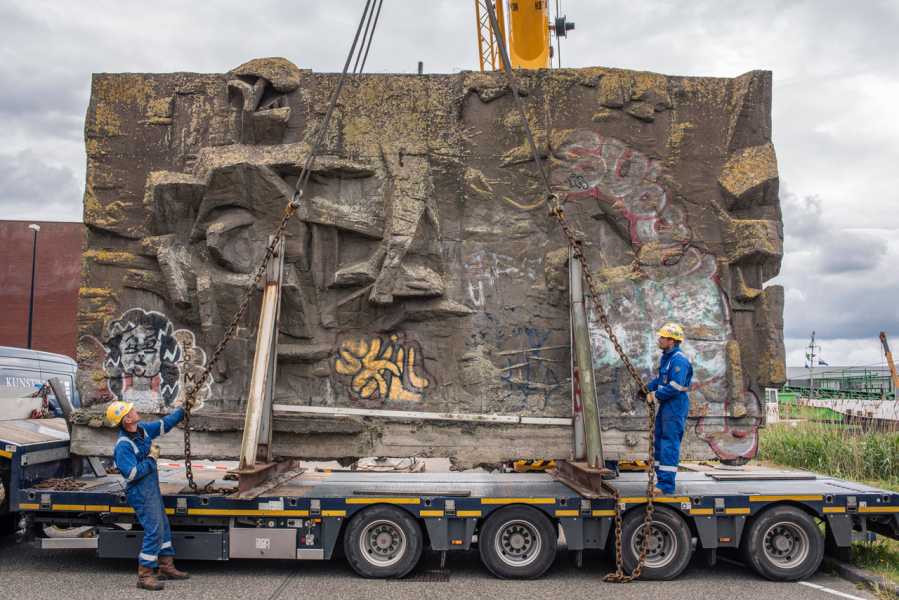Courtesy Erven Van Soest foto: Eddy Posthuma de Boer
Pierre van Soest: monumental artwork saved
Transport: end of May 2019
Repurposing in De Binckhorst: around 2022
Mediation and advice: Stroom The Hague
On May 31, 2019, a monumental 1965 artwork by Pierre van Soest was given a new home in The Hague. The unique concrete relief used to be part of Youth Building De Albatros in Amsterdam-North, which was demolished in 2001. After nearly 20 years of careful preservation, the work - an example of a highly successful collaboration between a visual artist and an architect - has been given a suitable reuse. In May, it was spectacularly transported by water from a site near the NDSM wharf in Amsterdam to the Binckhorst in The Hague. There it will soon receive a new and public existence as part of the Van Klingeren Pavilion (formerly Youth Hostel Ockenburgh), like De Albatros a design by architect Frank van Klingeren.
Postwar architecture and related art have been rapidly demolished in recent decades. This fate has befallen not only many works by Van Soest, but also many buildings by architect friend Van Klingeren. Van Soest focused on the need for monumental art as a painter during the reconstruction years, saying in an interview “Of course you have to deal with scale and architectural space. There is only one architect with whom I can get along, i.e. who lets me do my thing.” And that was Frank van Klingeren. A well-known architect in the 1960s, he specialized in multi-functional, cultural buildings, such as De Meerpaal in Dronten.
The concrete relief Van Soest designed for Van Klingeren's youth center in Amsterdam is reminiscent of the dynamics of postwar youth. The in total almost 20 meters long concrete mass folds around the entrance as a parapet. Not only is this an exceptional monumental work in terms of its plasticity and expressiveness, but it is pre-eminently characterized by the high degree of synthesis it achieves with the architecture. Certainly exceptional for Dutch monumental art of the 1950s and 1960s.
In Amsterdam, Van Soest's work was appreciated in time, expertly dismantled and stored. The same happened in The Hague a few years ago with Van Klingeren's Youth Hostel Ockenburgh in Kijkduin. It will be given a new location in The Hague's Binckhorst as the 'Van Klingeren Pavilion' and will become part of the Frank is a Binck(FIEB) project. Developer Stebru and the architects responsible for the reconstruction -Leon Thier and Gerrit van Es- came across Van Soest's concrete relief after a tip-off from Nora van Klingeren (the daughter of...) in Amsterdam. With the help of Bond Heemschut Amsterdam and the City of Amsterdam, and thanks to the mediation of Stroom Den Haag, the artwork will be preserved and once again be given a public appearance in synthesis with Van Klingeren's architecture.
It is often an impossible task to find a good destination for monumental wall art.In this case, Van Soest's artwork fits perfectly into the context of the renewed Van Klingeren Pavilion in terms of content and size.As if two old friends meet again posthumously.
Pierre van Soest (1930-2001)
Van Soest trained as a painter at the Rijksakademie in Amsterdam.He received the Royal Grant for Painting twice (1953 and 1954), exhibited twice at the Paris Biennale (in 1959 and 1961) and had a solo exhibition at the Stedelijk Museum in Amsterdam in 1978.He worked primarily in the field of monumental art, executing murals and concrete reliefs in public and private buildings. His work is included in numerous collections, including those of the Stedelijk Museum, Museum Boijmans van Beuningen and the Bonnefantenmuseum.















